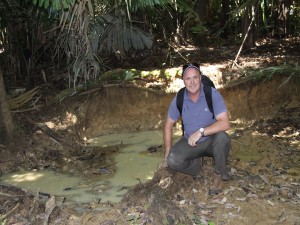The Biodiversity Research Group extends our heartiest congratulations to our group members Steve Wilson and Arthur Tuda (confirmed Cum Laude) for successfully defending and complete their PhD degrees! We wish you all the best in your future endeavours and look forward to seeing what you do next.
You can subscribe to our new YouTube channel – The Biodiversity Research Group – where we will post videos related to our various research projects. We hope you enjoy our first video on cross-boundary collaborations in the Himalayas. This news was also features on UQ’s Faculty of Science Webpage here.
A new paper by Lermite et al. (2021) compared the breeding success of native parrots and invasive common miners in urban settings where the latter is known to thrive. It was found that both birds utilised the experimental nest boxes equally. Despite this, the native parrots were found to have a significantly lower breeding success and parental nest attendance, as well as higher rates of hatch failure and nest disturbance. In light of these concerning findings, it is imperative that native parrot reproduction is further researched to identify what causes such challenges in urban environments and how these issues could be remedied.
A new paper by Wilson et al. (2020) explores the importance of muddy wallows to Javan rhino.
Only 72 Javan rhino (Rhinoceros sondaicuas) remain on the planet, found only in their last stronghold in Ujung Kulon National Park, West Java, Indonesia. Javan rhinos need to wallow regularly throughout the year, yet the role wallows play in their behaviour and their importance to the species remains little understood. In this study, we identified, mapped and studied 35 wallows in eastern Ujung Kulon National Park, where rhinos were active. We discovered that Javan rhino utilise wallows not only for thermoregulatory function, but also as sites of interaction and communication. This has important implications for conservation and potential translocation of rhinos, which will require finding sites with wallows and considering behavioural interactions and communication.
The management of complex and dynamic transboundary marine social ecosystems requires adaptive governance. In a new paper, Tuda et al. examined whether the marine co-management regimes that have developed on both sides of the Kenya-Tanzania border have structural conditions that can support adaptive governance. In this case study, it was found that differences in ocean governance systems between Kenya and Tanzania have resulted in different adaptive governance capabilities. In order to promote adaptive cross-border marine resource governance, the policy reforms in Kenya and Tanzania should allow the local ocean co-management systems to gradually develop into multiple semiautonomous decision‐making centers.
This case study has wider implications for other transboundary systems. You can read the full paper by Tuda et al. here.
This paper by Rogers et al. is about our local “agro” Aussie avians, i.e. which birds fight and why! To the best of our knowledge, this is the largest species interaction network published for Australian birds, which is interesting, in part, because Australian birds are generally considered to be some of the most aggressive birds in the world.
Some noteworthy findings include:
1. Aggressive interactions were dominated by the invasive common myna, the native noisy miner, and the native rainbow lorikeet.
2. For the common (Indian) myna, individuals that nest in natural tree hollows are likely to have a significant impact on native hollow nesting species that are similar in body size.
3. On average larger birds won aggressive interactions more frequently, with the exception of the common myna which won 26 of the 29 interactions against the larger native rainbow lorikeet.
These findings have some important implications for the applied management of invasive species such as the common myna. You can read more about it here.
“We aimed to identify marine areas to protect elasmobranch [shark and ray] species by means of a systematic spatial planning approach.”
Highlights from this study include:
1. A proactive area-based protection strategy towards elasmobranch conservation is proposed
2. Elasmobranch conservation priority areas were identified in the southern part of the western Mediterranean Sea
3. The addition of complex cost layers and zoning strategy did not alter conservation priority areas for elasmobranchs
You can read more about research findings here.
“We conducted detailed ground measurements of night-time brightness around the coast of Heron Island, a coral cay in the southern Great Barrier Reef of Australia, and an important sea turtle rookery… The methods we developed enabled us to overcome the limitations of commonly used ground/space borne remote sensing techniques, which are not well suited for measuring the light pollution to which animals are exposed.”
You can read the research findings in the full paper here.
“Understanding the drivers of invasive species’ range expansion is key to effective management and successful control… We radio-tracked mynas from invasion-front sites versus long-established sites in New South Wales.”
You can read the research findings in the full paper here.
During the stay at home directive over the last few months, lab member Dr Andrew Rogers, and his housemates Dr Matthew Holden, and Dr Russell Yong began to wonder exactly how many other things lived in their suburban home. Remarkably, in just over 6 weeks, they identified more than 500 species of plants, insects, amphibians, reptiles, mammals and birds. The project generated the #stayhomebiodiversity challenge, which has seen engagement across four continents, and received both local and international media attention. See our Outreach page for more details.






